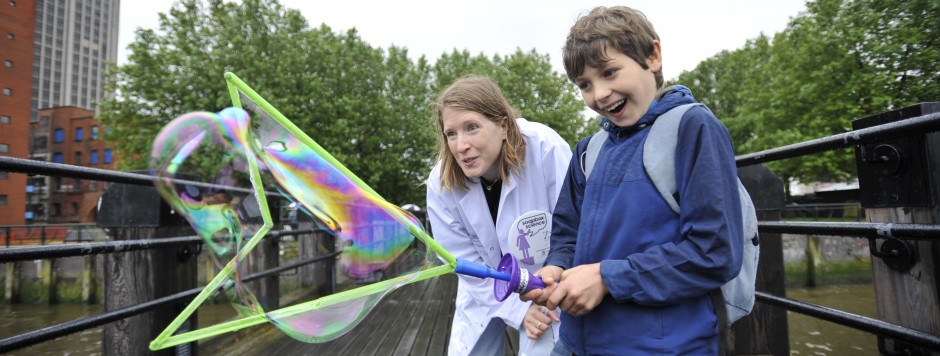 Sam Furfari is based at the University of Sussex as a Research Fellow working on the development of transition metal complexes. She took part in Soapbox Science Brighton on July 29th 2017 where she gave a talk entitled: “Coordination Chemistry: What is it and what can it be used for?”
Sam Furfari is based at the University of Sussex as a Research Fellow working on the development of transition metal complexes. She took part in Soapbox Science Brighton on July 29th 2017 where she gave a talk entitled: “Coordination Chemistry: What is it and what can it be used for?”
My experience with Soapbox Science, by Sam Furfari
On a rather rainy afternoon on the 29th of July 2016 I participated in the first Soapbox Science event in Brighton. It was a nerve racking and ultimately rewarding experience that I would encourage any female scientist to get involved with!
I was encouraged to apply for the event and I had several of my own reasons for doing so. I wanted to push myself outside of my comfort zone, I also wanted to showcase organometallic chemistry to the general public. I wanted to be able to show how many different ways metal-containing complexes can impact everyday life; from the production of fine chemicals, such as the Monsanto process which converts methanol into acetic acid (vinegar) using a rhodium catalyst, to enzymes that carry out important biological functions such as haemoglobin which transports oxygen around the body using an iron centre. The next challenge once I got accepted as a speaker was to deliver on that! I admit this was the hard step for me, trying to distil the work that I do into a manageable amount of information for the public to digest. I must give thanks to Katy Petherick, Leanne Harris and Beth Nicholls (from the Soapbox Science Brighton Committee) for helping develop my ideas.
Once I had a clear idea of what I would present on the day, it was time to get crafty! Making my main prop involved a lot of glue, Styrofoam balls and paint to make up a model of the complexes that I was working with. Plus, I borrowed some glassware from the teaching lab and model kits to show some other metal complexes that have uses in a variety of ways, from catalysts to anticancer therapeutics.



Prop construction
I think the most nerve-racking part of the experience was I had no idea what to expect from the audience and trying to prepare accordingly. Would they be mostly adults? Kids? Other scientists? Would I be able to answer all the questions that are thrown at me? Would they be interested enough to stay for the whole thing? What if I don’t know the answer? These were a lot of the questions that kept going through my head in the lead up to the event. I also tend to speak fast when I am nervous, so trying to make sure that I spoke clearly was going to be a challenge. The training session held at the University of Sussex helped to prepare me and answer some of these questions, but ultimately I just made sure that I was comfortable with the material I was going to present and the transitions when audiences moved between speakers and hope for the best on the day.
In the end, I walked off my Soapbox after my allotted hour on the biggest adrenaline high. I had a mixture of all sorts of people in the audience: kids that were interested in my colourful conical flasks; one bright student who threw me for a second asking about bonding structure of carbonate (CO32-); adults interested in the work I had done in Sydney and also what my current research could lead to in terms of ‘real-world’ applications. I had a lot of support from the organisers and it was nice to see some familiar faces in the audience to help calm the nerves. It was pointed out to me that my Aussie vernacular kept creeping through, calling ‘crisps’ ‘chips’ which would explain some confused looks I got.



A couple of shots from the day
I believe Soapbox Science is a great way of not only showcasing women in STEMM subjects, but also demonstrating just how varied science subjects can be. I think it is a great way of breaking down the stereotypes in the different disciplines and I hope that events like this can provide more role models in STEMM subjects that young girls can aspire to.
Dr Sam Furfari took part in Soapbox Science Brighton 2017 and was sponsored by the Royal Society of Chemistry Downland Section.
